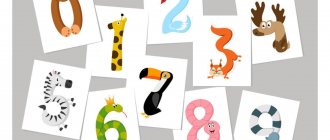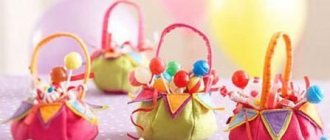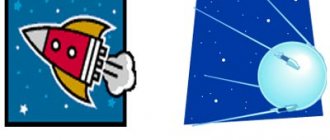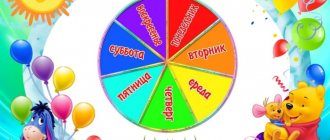Color and shape. Games with children 2-3 years old
Find the same figure.
Goal: To form an idea of the shape of objects. Learn to find identical objects by color and shape. Enrich your vocabulary with names of various shapes: circle, square, triangle. Reinforce knowledge about primary colors.
For the game you will need cards for each child with images of geometric shapes. The card shows two circles, a triangle and a square - a total of four shapes of different colors. The colors of the figures are different on all cards.
The teacher has geometric shapes: circles, squares, triangles of different colors.
At the beginning of the game, a bear cub addresses the children. He says that he was given a colored mosaic, he played with it, but now he can’t put it together correctly. Let's help the little bear.
The teacher takes one figure at a time and shows it to the children, while naming the figure by color and shape: “Here is a yellow triangle, who has the same mosaic?”
Children look at their cards, see if they have exactly the same figure. If the child finds the same figure, he takes the mosaic from the teacher and covers his figure with it. If no one takes the shown figure, then it is put aside.
The winner is the one who covers the figures on his card the fastest.
At the end of the game, the bear cub thanks the guys for their help.
Next time, new geometric shapes are added: rectangle, oval.
Let's put things in order.
Goal: To introduce children to the circle. Give the concept that a circle is the general shape of some objects.
To play you will need: Figures or toys of hares, a wheel, buttons, doll plates.
Once upon a time there lived a hare Kasyan. So he went into the forest and saw the wheel lying there. He wanted to take the wheel home, but he didn’t know if it was possible, in case it was someone else’s. A magpie flies past and sees a hare in thought. And this magpie knew everything about everything. And she says to the hare: “Take the wheel, it’s no one’s.”
The hare wanted to lift the wheel, but he couldn’t, it was too heavy. How can a hare carry a wheel home? (children's answers)
If the children do not guess on their own, the teacher shows how to roll the wheel.
So the hare Kasyan rolled his wheel home, and at home he was greeted by a hare and her babies. The rabbits saw the wheel and said: “Where did you get such a big button?”
“What kind of button is this, this is a plate,” says the hare.
“This is not a button or a plate, this is a wheel,” says the hare Kasyan. But the hare and the bunnies do not agree with the hare. The little bunnies shout: “Button.” The hare shouts: “Plate.”
This is how the hares argued, because they don’t know what a wheel, a plate and a button have in common.
What do you think these items have in common? Children look at a wheel, buttons, doll plates (children's answers).
After listening to the children’s answers, the teacher concludes: “All these objects have the same shape, they are round. All round objects roll."
Let's show the hares that the shape of these objects is the same. Children trace objects with their fingers and draw a circle with their fingers in the air.
Find the round object
.
Goal: Learn to find round objects among other objects. Develop mental operations: analysis and comparison. Enrich children's vocabulary.
To play you will need tables with four cells. A circle is drawn in the first cell, the remaining cells are empty. Object pictures, among which there should be round objects.
One day the bunnies were left alone at home and got so naughty that they scattered all the things from the closet. But soon the hare and the hare will return. The bunnies got worried, now the parents will come and argue. We need to put things in closets. Let's help the bunnies. You need to put round objects in the empty cells - boxes.
The teacher asks the kids to trace the drawn circle in the first cell with their finger.
“What objects do we need to find?” (round). The teacher explains that you need to take a picture and circle the object with your finger to determine whether it is round.
When the children complete the task, the teacher offers to tell the bunnies what objects the children put in the empty squares: Round clock, round table, round ball, round plate.
Mathematics for children 2-3 years old
Didactic games for children 2-3 years old.
Color Didactic games for children 2-3 years old.
Color and shape. 2014-10-26 15:37 admin
Senior group
We recommend these games on geometry for preschoolers in the older age group, that is, 5-6 years old.
Mosaic
For the game, prepare cards depicting objects made of geometric shapes. Invite the student to look carefully at the image, say what shapes he sees, whether they are large, whether there are many of them. Next, lay out the corresponding figures in front of the child and ask them to make an image similar to the one on the card.
When the preschooler begins to deftly complete the task, you can offer a complication: let him make an image without looking at the card. You can also invite the student to dream up: make another image from the same figures.
Pizza
To play, make a large circle - this will be the base of the pizza. Divide it into parts according to the number of children participating. Also cut out a lot of small shapes - this will be the filling for the pizza.
One child creates a geometric pattern on one of the pizza slices. The rest of the players must make the same pattern on their pieces. When the children have completed it, ask them what kind of figures they used and in what quantity.
If one child is playing, then name him the geometric objects that he should lay out as “filling”.
Fashionable glasses
For the game, prepare images of glasses with lenses of different geometric shapes. There should be holes instead of glass. Separately, cut out geometric shapes corresponding to the holes. The child’s task is to find suitable glasses for each glasses.
When the first task is completed, ask the student to find objects in the room and outside the window that are as close in shape as possible to the lenses of the glasses.
If two children are playing, encourage them to choose glasses with different lenses. Each player tries to find an object around that consists of two geometric shapes at once: like his own glasses and his friend’s glasses.
Ladybug wings
For the game, make images of ladybugs. They should have one wing, cut the second one separately. On the wings of insects, instead of black dots, different geometric shapes should be depicted; each ladybug has its own.
Lay out the blanks in front of the players, tell them that the bugs are playing too much and have lost their beautiful wings. We need to help them find them. Children find a suitable wing for each insect. Next, they count how many figured dots the bugs have on each wing and on both.
Find the extra figure
For the game, prepare cards, each of which depicts 4 geometric shapes. The game task is to find an object that does not correspond to the other three in most respects, and comment on the choice. For example, there is a small red circle, a large red circle, a small green circle, and a large yellow square. It is clear that the extra one is the last figure, since it does not correspond to the others in two of the three characteristics: shape and color.
Geometric competition
Make a playing field out of whatman paper: draw different figures on it. Two children are playing: they take turns throwing a die. For hitting a triangle, 1 point is given, for a square - 2 points, for a circle - 3 points, for a rectangle - 4 points. Before the game, you should agree on how many moves there will be. The player with the most points wins.
Collect the figures
For a board game, prepare images of figures lined up in a row. Moreover, objects should not be located chaotically, but in a certain order according to the principle of alternation. The task of the player who received the image is to continue the row and correctly select the next pieces in order. After completing the task, the player names the geometric objects that he used.
The game can be organized as a competitive one. Children play in pairs, the winner is the one who completes their row first. Further, it is possible to complicate the task: remove 2-3 objects from the row laid out by one player, and the second student must insert the correct figures into the empty areas.
Choose your figure
Prepare for the game large and small images of daisies with geometric shapes in the center. Place large flowers on the table. Let the children list the shapes they see. Ask the students to match each large daisy with a small one with a similar core.
Figured domino
For the game, make 28 pictures. Half of each of them should depict a certain geometric figure. Duplicate cards must have identical objects drawn on them. And the seventh duplicated picture must have both empty halves.
Place the cards on the table with the backs facing up. The game rules correspond to regular dominoes; the game starts with an empty duplicate card. The move is to lay out the card to the edge of the chain so that the same images are joined. If the player does not have a corresponding picture, then he takes the one he needs from the general pile. The first player to get rid of his cards wins.
Matryoshka dolls
For the game, prepare images of nesting dolls with geometric contours that form a pattern on the sundress. Separately cut out the shapes corresponding to the elements of the pattern.
Look at each geometric object with your children, let the children trace it with their finger and say what it is called. Next, invite the students to return the elegant look to the nesting doll sundresses. Children select shapes from a pile and place them on the contours of the sundress patterns.
Multi-colored balls
The didactic game “Match balls by color” reinforces ideas about the basic tones of the palette and develops the ability to correlate objects by shade. The exercise promotes speech development and attentiveness.
To play, you need a picture depicting a boy or girl with multi-colored ropes in his hand. You need to cut out balloons of the appropriate colors from cardboard.
The teacher, pointing to the picture, explains that the balloons came off and flew away. The task of preschoolers is to find the balloons that have flown away and correctly attach them to the ropes.
Caterpillar
The didactic game reinforces the idea of the main colors - red, yellow, green, blue.
The lesson promotes:
- the desire for knowledge;
- development of speech skills;
- formation of analytical ability and logic;
- development of attentiveness, perseverance, independence;
- gaining the ability to work with templates.
The activity requires four illustrations of caterpillars as empty circles with painted heads, as well as four colored circles of the appropriate diameter.
Children must make caterpillars from circles, guided by the color of their heads.
For older children, you can complicate the task: cut out circles of light-dark or warm-cold tones, ask them to arrange the caterpillars from beginning to end.
Place flowers in a vase
This version of the “Match by Color” game reinforces the idea of three basic tones - blue, red, yellow.
Lesson objectives:
- formation of cognitive and analytical abilities;
- improving finger motor skills;
- fostering perseverance, diligence, and the ability to work productively in a team;
- development of speech, expansion of vocabulary by including words related to the tones of the palette;
- improving the ability to visually perceive objects.
For the didactic game, you need to cut out three vases and many flowers of three corresponding colors from cardboard. The teacher places vases on the table and puts the flowers into piles according to color. Gives the children the task of choosing the correct group of flowers for each vase.
You can complicate the task to develop logic and attentiveness, mix the flowers in one pile. Pupils must correctly distribute the flowers among the vases.
Collection of didactic games
"Cars"
There are long and short strips of the same width on the table
The teacher invites the children to take one strip each. These are the “numbers” of the cars. And the gates are garages. Let the guys imagine that they are all “cars”, each with their own “number”. "Cars" will drive around the city. But as soon as the presenter says: “Cars, go to the garage!” - everyone must find their own garage and move into it. To do this, you need to attach the “number” of your car to the “number” on the gate. If the “numbers” are the same in length, you can move in.
During the game “Cars”, show the children an illustration. Ask them questions to help them make sense of what is happening.
The game is repeated 2 times.
"Merry dolls"
Purpose of the game: to teach to distinguish and compare objects according to different qualities of quantities.
Equipment: 2 sets of five-seater nesting dolls, 2 sets of circles of different sizes, a tower made of hollow cubes.
Progress of the game: At the invitation of the teacher, the children sit at a common table on which there is a nesting doll. The teacher turns to the children: “I want to play funny nesting dolls with you, but I see that there is only one nesting doll here, but where are the rest? (looks around, and then picks up a matryoshka doll and shakes it). Something is rattling in the middle! Let's see what's there? (Removes the upper half of the matryoshka doll). This turns out to be where they hid! (All nesting dolls are placed in a row). Let's get to know them! The teacher calls the name of each doll, tilting it: “I am Matryosha, I am Natasha, I am Dasha, I am Masha,” etc. Each child chooses one of the nesting dolls (the teacher takes one matryoshka for himself). The game begins. First, the nesting dolls walk (walk on the table). Then they are called to measure height. They line up one after another and take turns, starting with the smallest one, standing according to height, and the teacher clarifies which nesting doll is the smallest (tallest)? Then the nesting dolls go to dinner. The teacher puts on the table a set of circles (plates) of five sizes, calls the children in turn, who select plates of the appropriate size for their nesting dolls. After lunch, the nesting dolls get ready for a walk. The teacher puts the second set of nesting dolls on the table, and the children select girlfriends of the same height for their nesting dolls. Pairs of nesting dolls move around the table. Then they run away and mingle. (“The nesting dolls wanted to run”). Unnoticed by the children, the teacher removes a pair of nesting dolls of the same height from the table. "Time to go home! - says the teacher. Get into pairs." The nesting dolls are lined up in pairs, and suddenly it turns out that a certain pair of nesting dolls is missing. The teacher invites the children to call the nesting dolls by name (if they remember). Everyone asks her to come back in unison. The nesting dolls appear, the kids put them in place and the toys go home. The teacher places on the table a tower made of hollow cubes (one side is missing) - these are houses for nesting dolls. At the request of the teacher, each child finds a home for his nesting doll. The nesting dolls bow, say goodbye and go home.








